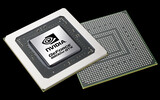Review mySN XMG7 (Clevo M570TU) Notebook
Intel Core 2 Extreme X9100 | NVIDIA GeForce 9800M GTX | 17.00" | 4.2 kg

The Nvidia GeForce 9800M GTX is a graphics adapter for laptops based on the G92 core. In general, the GPU is similar to that of the 8800M GTX but with 112 unified shader cores instead of 96. The chip is manufactured in a 65nm process and because of the high shader count, the power consumption (75 Watt of the MXM board) can be quite high. As a result, the 9800M GTX is only found in larger laptops with relatively powerful cooling solutions.
The performance of the chip is noticeably better than both the 9800M GT and GTS because of the additional shader units (see benchmarks below). Therefore, DirectX 10 games of 2008 should all be playable in high details.
As with all cards with DirectX 10 capabilities, the GeForce 9800M GTX renders 3D images using "Unified Shaders". Dedicated pixel- and vertex shaders have been dropped in favor of stream processors, which have now taken up much of the rendering burden. Furthermore, the shader units are higher clocked than the core chip itself at 1250 MHz.
A feature found in the GeForce 9000 series is the integrated PureVideo HD video processor. The GPU is able to assist the CPU in the decoding of H.264-, VC-1-, MPEG2- and WMV9 video material.
In conjunction with the Nvidia 9100M G integrated graphics, the 9800M GTX supports Hybrid-SLI known as HybridPower. HybridPower is a technique available only in Windows Vista that allows users to choose between the integrated or dedicated graphics core for power-saving purposes. Eventually, graphics switching was seamlessly accomplished through drivers by Nvidia, a technology now known as Optimus. GeForceBoost is not supported with the 9800M GTX as there would be no performance gain when paired the integrated GPU.
Compared to desktop graphics cards, the 9800M GTX should be a bit slower than the GeForce 8800 GT, which has a higher memory clock rate.
The 9800M GTX was eventually succeeded by the GTX 260M. The latter is based off of the G92b core architecture and is produced in a 55nm fabrication process, leading to lower energy demands and heat dissipation.
GeForce 9800M Series
| |||||||||||||||||||
| Codename | NB9E-GTX | ||||||||||||||||||
| Architecture | G9x | ||||||||||||||||||
| Pipelines | 112 - unified | ||||||||||||||||||
| Core Speed | 500 MHz | ||||||||||||||||||
| Shader Speed | 1250 MHz | ||||||||||||||||||
| Memory Speed | 800 MHz | ||||||||||||||||||
| Memory Bus Width | 256 Bit | ||||||||||||||||||
| Memory Type | GDDR3 | ||||||||||||||||||
| Max. Amount of Memory | 1024 MB | ||||||||||||||||||
| Shared Memory | no | ||||||||||||||||||
| API | DirectX 10, Shader 4.0 | ||||||||||||||||||
| Power Consumption | 75 Watt | ||||||||||||||||||
| Transistor Count | 754 Million | ||||||||||||||||||
| technology | 65 nm | ||||||||||||||||||
| Features | HybridPower, PureVideo HD, CUDA, PhysX ready | ||||||||||||||||||
| Notebook Size | large | ||||||||||||||||||
| Date of Announcement | 15.07.2008 | ||||||||||||||||||
| Information | MXM 3 | ||||||||||||||||||
| Link to Manufacturer Page | www.nvidia.com | ||||||||||||||||||
The following benchmarks stem from our benchmarks of review laptops. The performance depends on the used graphics memory, clock rate, processor, system settings, drivers, and operating systems. So the results don't have to be representative for all laptops with this GPU. For detailed information on the benchmark results, click on the fps number.
| low | med. | high | ultra | QHD | 4K | |
|---|---|---|---|---|---|---|
| Crysis Warhead | 77 | 15 | ||||
| Supreme Commander - FA Bench | 36 | |||||
| Crysis - GPU Benchmark | 109 | 67 | 41 | |||
| Crysis - CPU Benchmark | 119 | 59 | 37 | |||
| Call of Juarez Benchmark | 26 | |||||
| The Elder Scrolls IV - Oblivion | 77 | |||||
| Half Life 2 - Lost Coast Benchmark | 210 | |||||
| Doom 3 | 244.1 | 240.6 | 249.4 | 224.2 | ||
| < 30 fps < 60 fps < 120 fps ≥ 120 fps | 3 1 | 1 1 1 | 1 3 1 2 | 1 1 | | |
For more games that might be playable and a list of all games and graphics cards visit our Gaming List
These benchmarks were conducted with high end notebooks (quad-core desktop CPU). Therefore, the performance with slower laptops may decrease.
Crysis: 1280x1024, very high: 22 fps -> not playable (in high playable)
Enemy Territory: Quake Wars: 1600x1200: 80 fps -> fluently playable
Half Life 2 - Episode 2: 1600x1200: 68 fps -> fluently playable
Supreme Commander: 1600x1200: 55 fps -> fluently playable
World in Conflict: 1280x1024: 31 fps -> playable
AVADirect D901C: Intel Core 2 Quad (Desktop) Q9550, 17.00", 5.6 kg
External Review » AVADirect D901C
Sager NP9262: Intel Core 2 Quad (Desktop) Q9550, 17.00", 5.2 kg
External Review » Sager NP9262
SCHENKER XMG7 : Intel Core 2 Extreme X9100, 17.10", 4.2 kg
External Review » Schenker mySN XMG7
Rock Xtreme 780: Intel Core 2 Extreme QX9300, 17.00", 3.8 kg
External Review » Rock Xtreme 780
Zepto Hydra A17: Intel Core 2 Duo P8600, 17.00", 4.1 kg
External Review » Zepto Hydra A17
Toshiba Qosmio X305-Q725: Intel Core 2 Quad Q9000, 17.00", 4.1 kg
External Review » Toshiba Qosmio X305-Q725
» Comparison of GPUs
Detailed list of all laptop GPUs sorted by class and performance.
» Benchmark List
Sort and restrict laptop GPUs based on performance in synthetic benchmarks.
» Notebook Gaming List
Playable games for each graphics card and their average FPS results.
Top 10 Laptops
Multimedia, Budget Multimedia, Gaming, Budget Gaming, Lightweight Gaming, Business, Budget Office, Workstation, Subnotebooks, Ultrabooks, Chromebooks
under 300 USD/Euros, under 500 USD/Euros, 1,000 USD/Euros, for University Students, Best Displays
Top 10 Smartphones
Smartphones, Phablets, ≤6-inch, Camera Smartphones